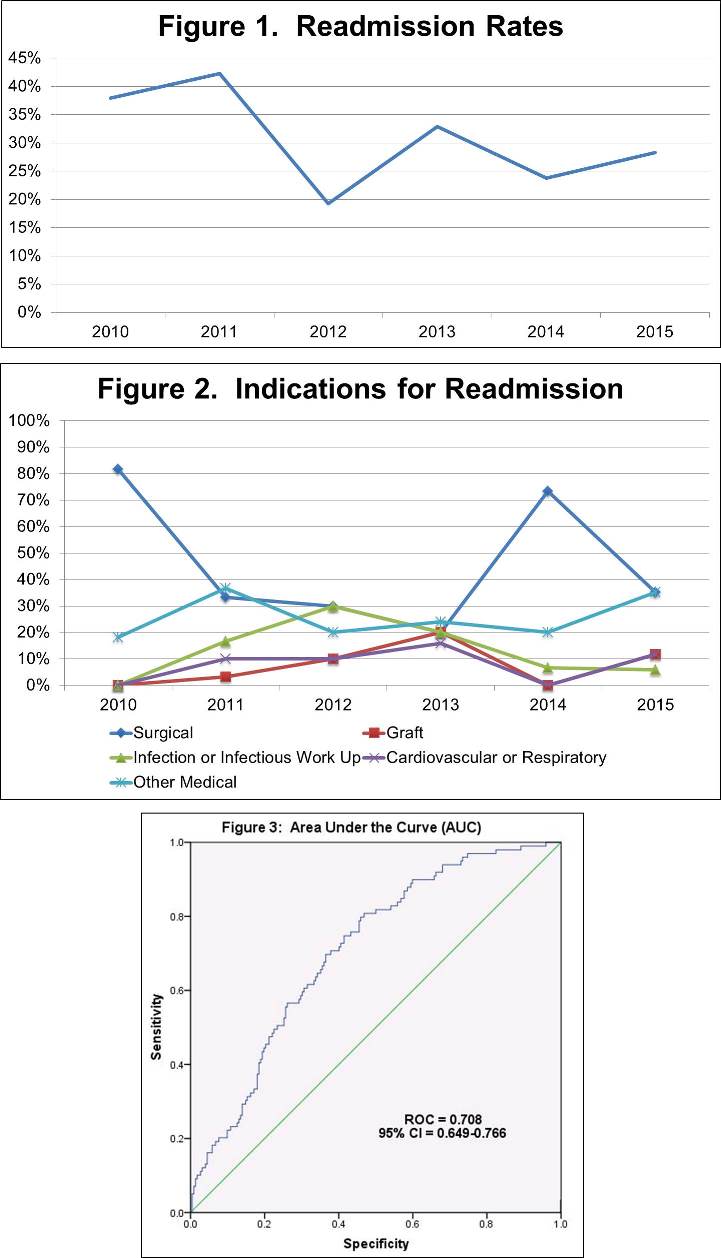Readmissions After Liver Transplantation–They May Be Predictable, but Are They Inevitable?
Dept of Tx Surgery, Tx ICCE, Dept of Pharmacy, MUSC, Charleston, SC
Meeting: 2017 American Transplant Congress
Abstract number: B202
Keywords: Liver transplantation, Post-operative complications, Resource utilization, Surgical complications
Session Information
Session Name: Poster Session B: Liver Retransplantation and Other Complications
Session Type: Poster Session
Date: Sunday, April 30, 2017
Session Time: 6:00pm-7:00pm
 Presentation Time: 6:00pm-7:00pm
Presentation Time: 6:00pm-7:00pm
Location: Hall D1
Purpose: Published studies suggest that approximately 40% of OLTx recipients are readmitted within 30 days. The aim of this study is to analyze the risk factors for 30-d readmissions following OLTx at a hospital that has developed protocols and allocated resources to preventing early post-transplant readmissions.
Methods: This was a retrospective cohort study of OLTx recipients from Jan 2010-Dec 2015. Pediatric patients and patients who were never discharged from the hospital were excluded. Patients were assessed for risk factors and variables that may have contributed to 30-d readmissions, and readmissions were analyzed for trends over time. Using this data, a predictive model was created using binary logistic regression with backward elimination.
Results: This study included 351 patients; a total of 108 (30%) were readmitted to the hospital within 30 days. Significant differences in baseline and transplant characteristics can be found in Tables 1-2. The majority of readmissions were surgical in nature, with biliary complications being the most common cause (Table 3). There were no statistically significant trends in the rate of readmissions or the cause of readmissions over time (Fig 1&2). The logistic regression model had good predictability with a ROC of 0.71 (CI 0.649-0.766, Fig 3) and included 9 variables (Table 4), 3 of which were protective.
Conclusions: The results of this study demonstrate that rates of 30-d readmission in the OLTx population are stable over time and similar to the published literature. While there are variables that are predictive of 30-d hospital readmissions in OLTx recipients, it appears that these predictive factors may be center-specific, challenging to prevent, and thus difficult to influence over time.

CITATION INFORMATION: O'Brien B, Mardis C, Mardis A, Fleming J, Meadows H, Patel N, Pilch N, Perez C, Sell M, Rogers A, Lee I, McGillicuddy J, Chavin K, DuBay D, Taber D. Readmissions After Liver Transplantation–They May Be Predictable, but Are They Inevitable? Am J Transplant. 2017;17 (suppl 3).
To cite this abstract in AMA style:
O'Brien B, Mardis C, Mardis A, Fleming J, Meadows H, Patel N, Pilch N, Perez C, Sell M, Rogers A, Lee I, McGillicuddy J, Chavin K, DuBay D, Taber D. Readmissions After Liver Transplantation–They May Be Predictable, but Are They Inevitable? [abstract]. Am J Transplant. 2017; 17 (suppl 3). https://atcmeetingabstracts.com/abstract/readmissions-after-liver-transplantation-they-may-be-predictable-but-are-they-inevitable/. Accessed January 4, 2026.« Back to 2017 American Transplant Congress
